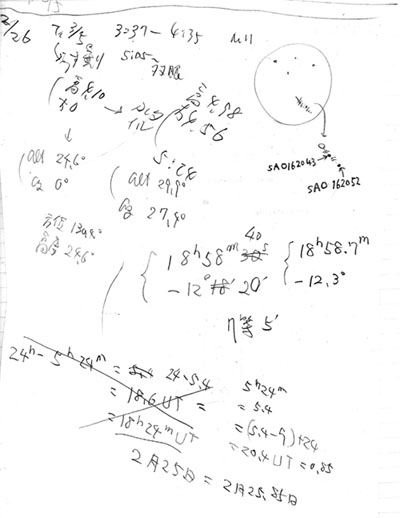On February 26, 2004, I spotted a bright comet, but it had never been observed again.
I began comet hunting at 3:37a.m. (Japan Standard Time) using the 46 cm telescope. The sky was not very clear and I searched in the gaps of the clouds. At 4:35, 20 minute before the beginning of the twilight, the sky turned to overcast. I started taking down my telescope as there seemed no prospect for the recovery of the weather.
Just when I completed loading my comet-seeker onto my car, suddenly, the sky got clear. I did not have enough time to set up my 46 cm telescope again, and I carried 15x110 mm binocular from my apartment (I was observing near my apartment).
I started searching from the horizon and moved the bino horizontally. Several deep sky objects, M19, M62, M8, M20, M17 and M18 came into the FOV. At 5:24a.m. when I was about to finish the session, I encountered a globular-cluster-like object with 7th magnitude and dia.=5', but I could not identify it on the map. It must be a comet and was fairly bright. I thought the comet might have been already discovered. It was difficult to determine the exact position since the twilight had already begun some 30 min. before. I measured the angles between the possible comet and Altair using the graduated rings installed in the binocular mount. I drawn a simple sketch and the comet disappeared from the FOV in 5 minutes into the twilight.

Sketch and memo on February 26, 2004.
I could determine the position with good accuracy in my room using the digital map, MetaStar5: 18h58.7m, -12.3 deg. in the constellation of Scutum. The altitude at the time of discovery was 25 deg. above the horizon. I heisted to report this discovery because I could not observe the motion. After all, at 8a.m. I sent an email to Syuchi Nakano, CBAT and a fax to NAO Japan. The next day, it was snowy in my city and I drove 4 hours to the site where the sky was clear. I could see nothing at the position. Nakano called me and said that no one could confirm the object.
I believe it must be a real comet, probably the near earth comet. I think what I did was correct. If it is a periodic comet, it might be confirmed many years later.
I have read in Tsutomu Seki's publication that Minoru Honda spotted a possible new comet moving fast. A certain Japanese comet hunter told me a similar story. They seemed not to report their discovery to CBAT or NAOJ because of the fast motions. There may be many comets like these, but it is difficult to confirm them unless you take photos of the objects.